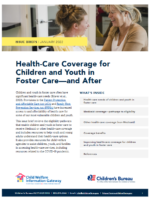Resource Family Handbook
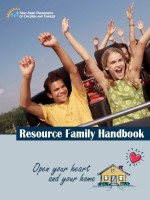
There are three types of Resource Family Care providers: foster, adoption, and kinship. Foster caregivers are individuals and families who voluntarily open their hearts and homes to become temporary parents to children in need of a home due to protective or other social service reasons.
Adoptive caregivers provide permanent care for children whose parents have had their parental rights terminated.
Kinship caregivers are related to a child in placement through blood, marriage, civil union, domestic partnership, or adoption. Kinship caregivers may also be connected to the child by an established positive psychological or emotional relationship.
While children are in placement, the resource family offers them loving experiences that promote healthy growth and development. They provide the vital physical and emotional care that children need when they are separated from their biological parents. Foster and adoptive caregivers must first be licensed to provide care. Kinship caregivers may provide care before being licensed if they’re eligible for licensure and are in the process of being licensed.
Supporting Youth in Foster Care In Making Healthy Choices

Youth in foster care or kinship care often have experienced abuse, neglect, chaotic living situations, and placement(s) away from their families. Their histories can lead to complicated emotions and behaviors, and many experience trauma. While youth can heal, often it will take small steps over time with stability, supports, and services.
Tomando Decisiones Saludables

Haciendo lo que puedas para sentirte lo mejor possible.
Todos podemos beneficiarnos al aprender qué hacer para tener buena
salud. Los jóvenes en cuidado de crianza (foster care) tienen que enfrentar
muchas cosas estresantes en sus vidas. A menudo, se sienten muy heridos
emocionalmente. A veces sus capacidades de manejar los problemas están
agotadas. Pueden necesitar ayuda en resolver cómo manejar sus sentimientos y
mejorar su salud.
Los adolecentes que se sienten tristes o enojados puede que se sientan mejor si
hablan con una persona en quien confían, si hacen algún pasatiempo preferido
o si hacen ejercicio o juegan un deporte. Los jóvenes que se sienten muy mal o
que se comportan de manera inesperada a menudo necesitan ayuda y apoyo
de otras personas. A veces necesitan terapia y/o medicamentos que los puedan
ayudar a controlar sus emociones y sus comportamientos.
Cuando estás herido, a menudo hay varias cosas que puedes hacer para sentirte
mejor. Imagina si te caes y te lastimas el tobillo—puedes tomarte un calmante,
tratar de no caminar sobre él y/o aplicarle hielo. De la misma manera, cuando
te sientes herido emocionalmente, puedes tomar medicamentos, y evitar las
actividades que empeoran la condición.
Eat Well, Live Well, Be Well

Having the tools and information to make healthy choices and knowing how to prevent illness is a key part of staying well. This book is intended for individuals who may be living on their own for the first time and not know how to set up a kitchen, shop for groceries, or the basics of cooking. The recipes contained in this book are a sample of recipes
that contain a limited number of ingredients and steps, to make it relatively easy for individuals to shop and eat healthier.
Foster Kids in Limbo
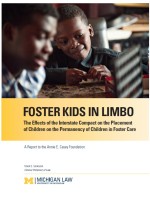
EACH YEAR, child welfare agencies make over 40,000 requests for home studies to determine whether children in foster care can
be placed with parents, relatives and others living in another state.
Each of these requests is governed by the Interstate Compact on the Placement of Children (“ICPC”), a uniform law adopted by every state to coordinate the placement of foster children in other states. Under the ICPC, a child can only be placed in foster care in another state after the receiving state conducts a home study and approves the proposed placement.
Resource Family Handbook

There are three types of Resource Family Care providers: foster, adoption, and kinship. Foster caregivers
are individuals and families who voluntarily open their hearts and homes to become temporary parents
to children in need of a home due to protective or other social service reasons.
Adoptive caregivers provide permanent care for children whose parents have had their parental rights
terminated.
Kinship caregivers are related to a child in placement through blood, marriage, civil union, domestic
partnership, or adoption. Kinship caregivers may also be connected to the child by an established positive
psychological or emotional relationship.
While children are in placement, the resource family offers them loving experiences that promote
healthy growth and development. They provide the vital physical and emotional care that children need
when they are separated from their biological parents. Foster and adoptive caregivers must first be
licensed to provide care. Kinship caregivers may provide care before being licensed if they’re eligible
for licensure and are in the process of being licensed.
Adoptive Parent Handbook
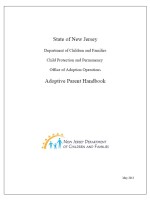
The decision to adopt a child and fully accept that child as your own is not often made with ease. There is a lot to consider before you make such a commitment. This handbook will provide you with important information regarding general characteristics of available children, who can adopt and a step by step guide regarding the adoption process.
10 Tips For Foster Parents To Help Their Foster Youth Avoid Teen Pregnancy

The good news for parents and other caring adults,
including foster parents, is that there is much they can
do to help influence their children’s decisions about sex.
Foster youth say they want to discuss sex, love, and relationships
with their foster parents, but some are embarrassed or feel
uncomfortable starting the conversation. The same holds true
for foster parents. They often don’t know what to say, how to say
it, or when to start. This guide offers some ideas to help foster
parents strengthen their relationships with foster youth. It also
offers some ideas on how best to communicate about sex, love,
and relationships.
Be a Foster or Adoptive Parent
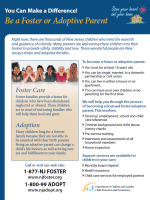
Right now, there are thousands of New Jersey children who need the warmth
and guidance of a family. Many parents are welcoming these children into their homes to provide safety, stability and love. These wonderful people are New Jersey’s foster and adoptive families.
- « Previous Page
- 1
- …
- 5
- 6
- 7
- 8
- 9
- …
- 16
- Next Page »

